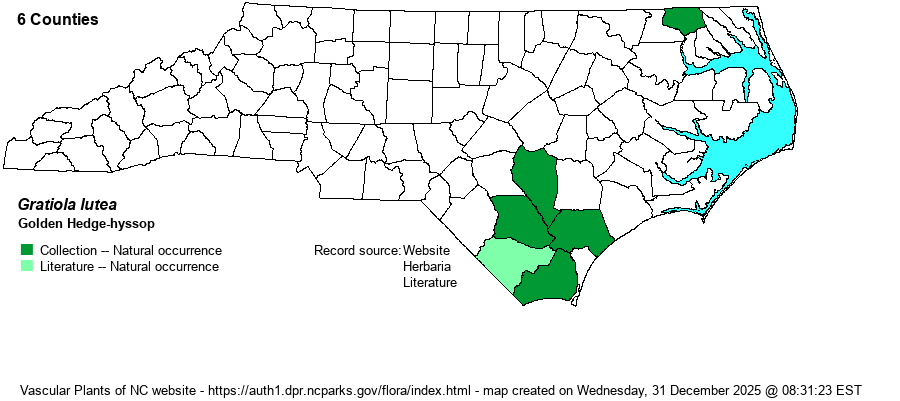| Author | Rafinesque | |
| Distribution | Nearly restricted to the southeastern corner of the state, from Sampson County to the SC state line. Also recorded from the northern Coastal Plain in Gates County, where now historical. Likely to occur in the intervening Coastal Plain counties.
Despite the range in NC, this is a species with a wide north-south range close to the Atlantic coast. It ranges north into eastern Canada, and south sparingly though all Atlantic states south to the FL Panhandle and west to AL. Most U.S. occurrences are actually in New England.
| |
| Abundance | Rare and local, and sporadic in its appearance, owing to water levels in the blackwater riverine habitats it prefers. Casual to accidental now north of Sampson County, even though the northern two-thirds of the Coastal Plain are within the overall range. This is a State Special Concern species. | |
| Habitat | In NC, this species is mainly found in the wet mud of recent drawdown zones of a few blackwater rivers, less so on smaller creeks. It can also be found in other swampy ground, such as in a ponded Carolina bay with cypresses, though most NC records in the NCNHP database are from along the Black River and the Waccamaw River. | |
| Phenology | Blooms from May to September, and fruits shortly after flowering. | |
| Identification | This is a slender and usually branching herb, growing only to about 8 inches tall or long. Compared with other Gratiola species, it has a more sprawling look. There are numerous pairs of small opposite leaves along the stems, with each leaf being sessile and thus essentially clasping the stem, mostly ovate, but only about 3/4-inch long and half as wide. Leaves are usually entire but may have a few teeth. If seen only vegetatively, experts probably can identify it, but most likely would overlook it; however, when it blooms any doubt is erased. It has bright golden yellow flowers, not at all tiny, from some of the upper leaf axils; these flowers are nearly "rotate" (almost completely symmetrical when viewed from the front) and about 3/4-inch long (includes the tube in back) and 1/2-inch across, easily spotted from some distance if paddling along a river or walking along a shoreline. All of the other Gratiola species in the state have white flowers (usually striped with purple). This is a tricky species to find, as you may target one of these several blackwater rivers in midsummer for canoeing or walking the edges, and if the rivers are too high, you almost certainly will not see the plants. Thus, finding this plant, especially in bloom, may take persistence but you will be well rewarded if you succeed. | |
| Taxonomic Comments | Most references name the species as Gratiola aurea.
| |
| Other Common Name(s) | Yellow Hedge-hyssop | |
| State Rank | S1 | |
| Global Rank | G5 | |
| State Status | SC-V | |
| US Status | | |
| USACE-agcp | | |
| USACE-emp | | |

